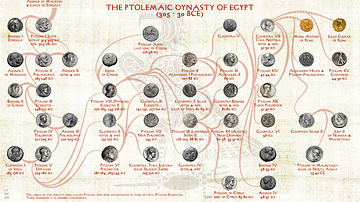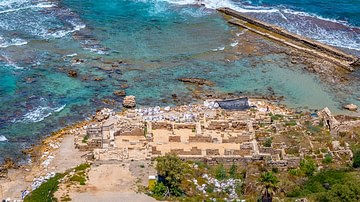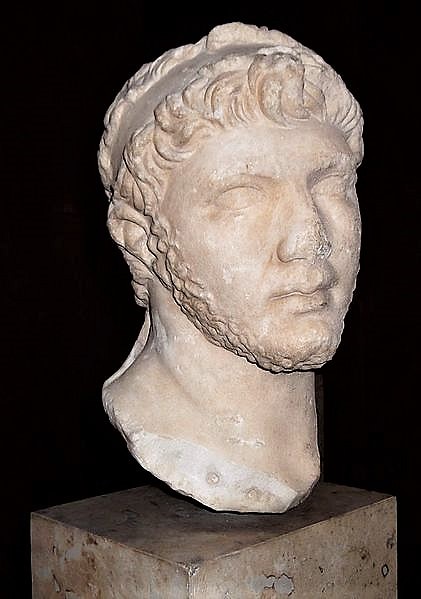
Ptolemy of Mauretania (r. 23-40 CE) was king of Mauretania and one of the last surviving members of the Ptolemaic dynasty. His father Juba II (c. 48 BCE to 23 CE) was a Numidian royal and his mother Cleopatra Selene II (40 to c. 5 BCE) was the daughter of Cleopatra (69-30 BCE) and Mark Antony (83-30 BCE).
Ptolemy was executed by his cousin the Roman emperor Caligula (r. 37-41 CE) in 40 CE. Ancient accounts implied that Caligula killed Ptolemy out of jealousy, but modern historians have suggested that Caligula feared that Ptolemy was conspiring against him. Ptolemy was the last known member of the Ptolemaic dynasty, and upon his death, Mauretania was made into a Roman province.
Early Life & Ancestry
Ptolemy was born in Mauretania to Juba II and Cleopatra Selene II between c. 13 and 9 BCE. Juba II was the son of Juba I of Numidia, who committed suicide after being defeated by Julius Caesar (100-44 BCE). Cleopatra Selene II was the daughter of Mark Antony and Cleopatra, who both committed suicide after being defeated by Julius Caesar's heir Augustus at the Battle of Actium. Both Juba II and Cleopatra Selene II had been captives in Rome after their respective kingdoms were conquered by the Romans. They were both raised within the imperial household, and a marriage between them was eventually arranged by Augustus' sister Octavia.
Upon their marriage, Augustus appointed them vassal-kings of Mauretania which they ruled on behalf of the Roman Empire. Ptolemy is the only known son of Juba and Selene, although they had been married for several years before his birth. Some historians have speculated that he may have had an older brother, who is depicted on the Ara Pacis. Ptolemy also had at least one sister, who is honoured in an inscription from Athens.
Juba II eventually transformed his residence Caesarea (Cherchel) into a little Alexandria with an important library that became a centre of culture and learning. To foster family history, Egyptian art was transported to the region and we can infer from the Ptolemaic portrait busts found there that a sort of gallery of ancestors was set up there. (Hölbl, p. 250-251)
Ptolemy was named according to Ptolemaic tradition, referencing his mother's ancestors. This choice of name bypassed Juba's family entirely and presented Ptolemy as a successor to the Ptolemaic dynasty. Through his grandfather Mark Antony, Ptolemy was related to the imperial family. The emperors Caligula, Claudius (r. 41-54 CE) and Nero (r. 54-68 CE) were his cousins, as were the Roman notables Germanicus, Valeria Messalina, and Drusus Caesar. Both Ptolemy and his parents were Roman citizens, a status often given to allied monarchs.
Ptolemy was sent to Athens for his education, as was common for aristocratic youths in the Roman Empire. He is honoured in an inscription from the Ptolemaion, a gymnasium founded by his ancestor Ptolemy II. Although his father Juba II was an accomplished scholar, Ptolemy was not known for his intellectual accomplishments. The Roman historian Tacitus characterized Ptolemy as an immature and lazy king. Much of his early life would have been divided between Rome and Caesarea (North Africa), the newly rebuilt capital of Mauretania. The cosmopolitan city combined Berber, Greek, and Egyptian culture, which shaped Ptolemy's upbringing.
Co-Ruler of Juba II
Around 5 BCE, when Ptolemy was a young man, Selene died of natural causes, and Juba remarried. Juba began delegating royal responsibilities to Ptolemy about 10 years later, in part due to the fact that the old king was feeling his age. Ptolemy began to be minted on coins in 5 CE, but his regnal years did not begin until at least 17 CE. During this period, Ptolemy and Juba were co-rulers.
Mauretania was at that time sparsely populated, with most of its larger settlements located along the coast. Although the kingdom was geographically massive, the majority of the country was only lightly inhabited. Its frontiers were constantly threatened by incursions from the barbarian Gaetulians and Garamantes. These pastoral tribes were unhappy because of increasing Roman incursions into their territory and the settlement of farming communities in their lands. Unrest in Roman Africa, a neighboring province, often spilled into Mauretania.
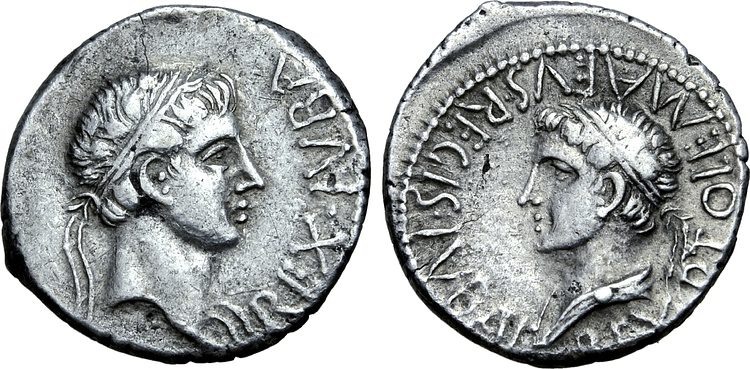
The rulers of Mauretania were supported by legions of the Roman army who assisted them in defending their frontiers. However, the conscription of locals into the Roman auxiliaries created further resentment. In 15 CE, Tacfarinas, a Gaetulian conscript, deserted his Roman legion and led a rebellion. He united disaffected tribes in Roman Africa, training them in the tactics of Roman warfare. Deserting auxiliaries were also absorbed into his growing army, which was becoming a more disciplined force than had previously been mustered by these tribes. These events took place shortly after Augustus' death, which may have created a sense of instability or weakness on the frontiers.
For Tacfarinas, though often driven back, had recruited his resources in the interior of Africa, and had become so insolent as to send envoys to Tiberius, actually demanding a settlement for himself and his army, or else threatening us with an interminable war. (Tacitus, 3.73)
Tacfarinas' revolt began with light raiding but eventually escalated into all-out assaults and sieges on Roman positions between Libya and Mauretania. The Romans led a successful retaliation against the rebels, who resorted to guerilla tactics as Roman forces proved superior in pitched battles. Tacfarinas' forces would strike rapidly at a town or a Roman fort before retreating into the desert to avoid Roman reprisals. Because Tacfarinas' attacks also targeted Mauretania, Juba and Ptolemy were obliged to wage war against him as well.
Tacfarinas was defeated by the Roman proconsul Quintus Junius Blaesus and retreated to the desert to regroup. Blaesus established Roman forts along the African frontier and an increased military presence in the region. After Blaesus' victory, Augustus' successor Tiberius (r. 14-37 CE) considered the war concluded and withdrew Legio IX Hispania from Mauretania. The Roman withdrawal and death of Juba II in 23 CE encouraged more tribes to join Tacfarinas' cause.
Sole Rule
Ptolemy was considered a young and weak ruler in comparison to his father and had to quell rebellions in Mauretania shortly after Juba's death. This was followed by renewed assaults from Tacfarinas. A joint Roman-Mauretanian force was led by Ptolemy and the new proconsul Publius Cornelius Dolabella. To more easily pursue and harass Tacfarinas' more agile troops, Dolabella divided their forces into four columns and led rapid assaults on the rebels. Eventually, the Roman-Mauretanian forces were able to ambush Tacfarinas, who had encamped in a destroyed Roman fort at Auzea. Here Tacfarinas, his family, and his bodyguard were killed, effectively scattering the rebellion.
This conflict cemented Ptolemy's reputation as a capable general and a loyal ally of Rome. For his victories, he was given a Roman triumph by Tiberius in 24 CE. Accordingly, he was permitted to use other insignias of rank such as a laurel wreath, an ivory baton, and an embroidered purple and gold toga. Like other Mauretanian kings, Ptolemy wore a cloak dyed Tyrian purple, using a lavishly expensive dye produced in Mauretania. He was a distinctive figure in Roman high society on account of his flashy clothing and good looks.
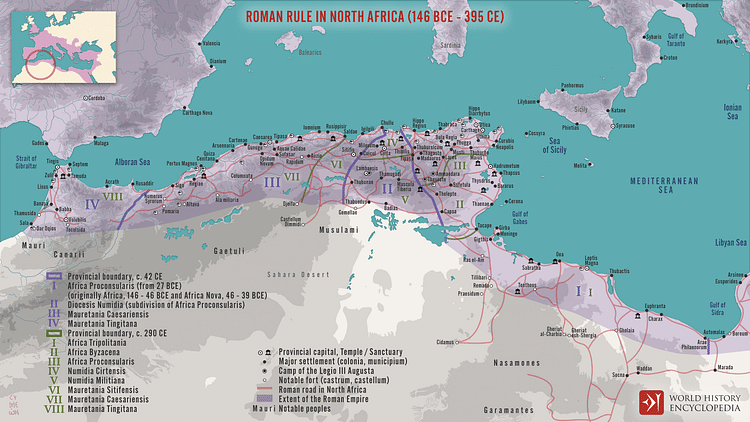
By the end of his reign, Ptolemy had amassed considerable personal wealth. Much of this fortune had been created by the policies of his parents, who encouraged agricultural expansion and more intensive trade. The production of Tyrian purple, garum (fish sauce in the ancient world), and other commodities added to the Mauretanian royal family's income. He eventually minted issues of gold coins, an act that put this wealth on public display.
In addition to his role as king of Mauretania, Ptolemy was duovir, or magistrate, of Gades and Carthago Nova in Roman Spain. He also spent considerable time in Greece and was honoured by the independent Lycian federation. He was married to Julia Urania, who was possibly related to the royal family of Emesa, a kingdom in modern Syria. Around the end of his reign, Ptolemy fathered a daughter named Drusilla. She was likely named after Augustus' wife Livia Drusilla or Caligula's sister Drusilla.
Death
In the winter of 39/40 CE, Ptolemy was summoned to Caligula's court in Lugdunum for questioning. The reason for this summons is unknown, but Caligula evidently became displeased with Ptolemy and had him executed shortly after. Caligula was infamously hostile towards other members of the imperial family. The fact that Ptolemy was related to the emperor probably put him in danger, but it does not completely explain Caligula's actions.
The emperor's violent and capricious behavior contributed to an overall negative portrayal in Roman historical accounts. The surviving sources disagree over the exact reason for Ptolemy's murder, but they all attribute it to petty jealousy. Cassius Dio claimed that learning of Ptolemy's wealth angered Caligula, while Suetonius wrote that Caligula was jealous of the Mauretanian purple cloak. Ptolemy's increasing wealth and political activities outside of Mauretania might have made it appear that he had imperial pretensions. His reckless and arrogant display of luxury and triumphal insignia would only have confirmed these fears in Caligula's mind.
Some modern historians have theorized that Caligula suspected Ptolemy of being involved in a conspiracy against him. Ptolemy was associated with several relatives and colleagues of Caligula who were under suspicion, including the emperor's sisters Agrippina the Younger and Julia Livilla. Even more damning, Ptolemy was friends with Gaetulicus, a popular general at the center of a supposed conspiracy against Caligula. Gaetulicus' father Cossus Cornelius Lentulus had suppressed Gaetulian raids as proconsul of Africa, making him a colleague of Juba II.
Gaetulicus had been friends with Sejanus, a powerful commander of the Praetorian Guard executed for his role in a conspiracy against Tiberius. Gaetulicus had avoided any consequences from Sejanus' downfall and held onto his post as governor of Germania Superior. In 39 CE, Caligula prepared a military expedition to Germania where barbarian raids were a recurring problem. The hidden purpose of this expedition was probably to deal with Gaetulicus. Motivated by fear that Caligula intended to remove him, Gaetulicus formed a conspiracy to overthrow the emperor and replace him with a successor. Caligula's sisters and his brother-in-law Lepidus were involved in this plot.
The ancient sources do not say who revealed the scope of the plot, but it may have been Gaetulicus, who was arrested first. Gaetulicus and Lepidus were promptly executed while Caligula's sisters were exiled. The revelation of this conspiracy made Caligula increasingly paranoid about potential assassins. The connection between Ptolemy and the conspirators, combined with Ptolemy's lack of tact, might have sealed his fate. There is no evidence to suggest that Ptolemy actually knew of the conspiracy, but this was not enough to save him.
Within a year of Ptolemy's execution, Caligula was assassinated by his Praetorian Guard. A revolt led by Aedemon, one of Ptolemy's followers, broke out in Mauretania shortly after Ptolemy's execution. Caligula's successor Claudius eventually annexed the kingdom and made it into a Roman province in 44 CE. The death of Ptolemy is considered by some to mark the end of the Ptolemaic dynasty.



